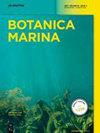Differences between the wild-type and cultivated Gracilariopsis lemaneiformis revealed by quantitative proteome and gene expression profiling analysis
IF 1.4
4区 生物学
Q2 MARINE & FRESHWATER BIOLOGY
引用次数: 0
Abstract
Abstract The seaweed Gracilariopsis lemaneiformis is widely cultivated in the southern and northern coasts of China, and is mainly used for agar extraction and abalone feed. The cultivated strain of G. lemaneiformis 981 has various advantages over the wild type such as growth rate and high-temperature tolerance. Therefore, it is necessary to investigate the differences between the wild-type and cultivated G. lemaneiformis . Here, 648 up-regulated and 837 down-regulated proteins were screened using the isobaric tags for relative and absolute quantitation (iTRAQ) technique, and these differentially expressed proteins (DEPs) were concentrated in the pathways including “Ribosome”, “Photosynthesis-antenna proteins”, “alpha-Linolenic acid metabolism”, and “Phenylpropanoid biosynthesis”. The most prominent pathway was “Ribosome”, namely, 116 out of 119 ribosome-associated proteins were up-regulated in G. lemaneiformis 981 compared to the wild type. Subsequently, multiple reaction monitoring (MRM) validated the credibility of the iTRAQ results. Finally, “Phenylpropanoid biosynthesis” and “Photosynthesis-antenna proteins” pathways were also found to be significantly changed in G. lemaneiformis 981 validated by gene expression profiling analysis. Altogether, these results, in combination with chlorophyll fluorescence parameters, unveiled the possible mechanism of differences in growth and anti-abiotic stresses between the wild-type and cultivated G. lemaneiformis , which would provide a reference for breeding of excellent seaweeds.通过定量蛋白质组学和基因表达谱分析揭示了野生型和栽培型薄叶茅的差异
摘要:细叶草(Gracilariopsis lemaneiformis)是中国南北海岸广泛种植的海藻,主要用于琼脂提取和鲍鱼饲料。lemaneiformis 981栽培菌株在生长速度和耐高温性等方面优于野生型。因此,有必要对野生型与栽培型的差异进行研究。本研究采用等压标签相对绝对定量(iTRAQ)技术,筛选了648个上调蛋白和837个下调蛋白,这些差异表达蛋白(DEPs)集中在“核糖体”、“光合天线蛋白”、“α -亚麻酸代谢”和“苯基丙烷类生物合成”等途径中。最突出的途径是“核糖体”,即与野生型相比,G. lemaneiformis 981中119个核糖体相关蛋白中有116个上调。随后,多重反应监测(MRM)验证了iTRAQ结果的可信度。最后,通过基因表达谱分析,发现G. lemaneiformis 981的“苯丙类生物合成”和“光合作用-天线蛋白”途径也发生了显著变化。综上所述,这些结果结合叶绿素荧光参数,揭示了野生型和栽培型lemaneiformis在生长和抗非生物胁迫方面差异的可能机制,为优质海藻的选育提供参考。
本文章由计算机程序翻译,如有差异,请以英文原文为准。
求助全文
约1分钟内获得全文
求助全文
来源期刊

Botanica Marina
生物-海洋与淡水生物学
CiteScore
4.10
自引率
4.50%
发文量
43
期刊介绍:
Botanica Marina publishes high-quality contributions from all of the disciplines of marine botany at all levels of biological organisation from subcellular to ecosystem: chemistry and applications, genomics, physiology and ecology, phylogeny and biogeography. Research involving global or interdisciplinary interest is especially welcome. Applied science papers are appreciated, particularly when they illustrate the application of emerging conceptual issues or promote developing technologies. The journal invites state-of-the art reviews dealing with recent developments in marine botany.
 求助内容:
求助内容: 应助结果提醒方式:
应助结果提醒方式:


